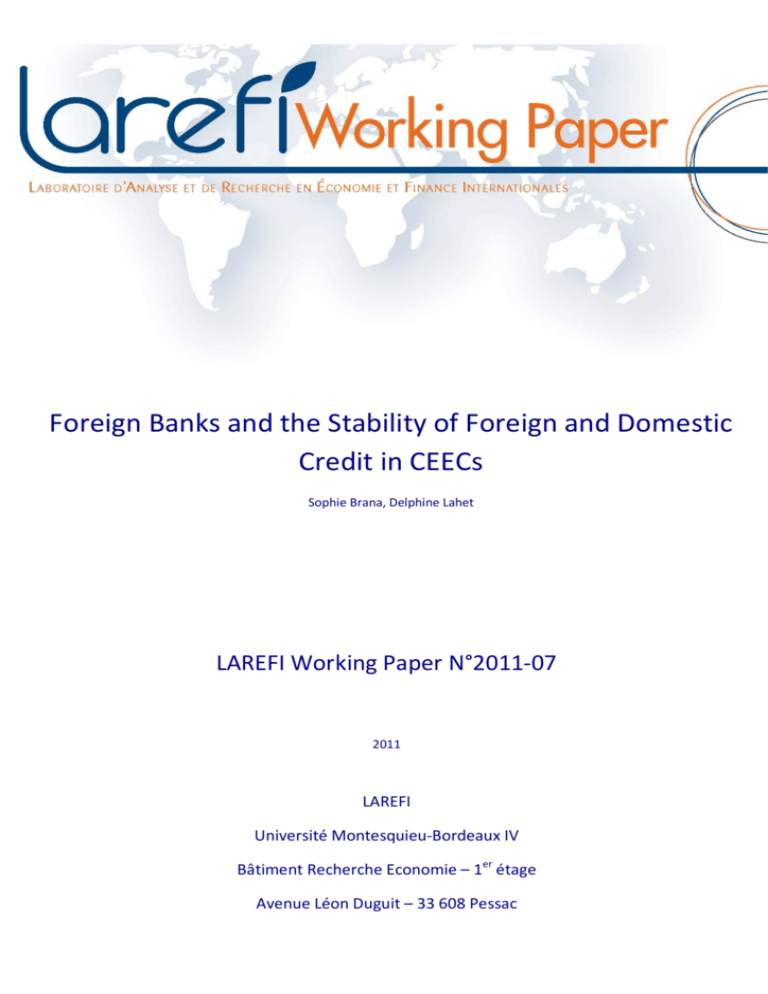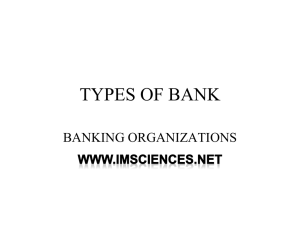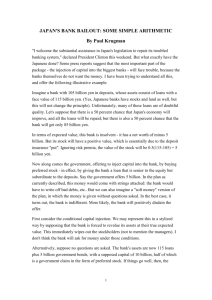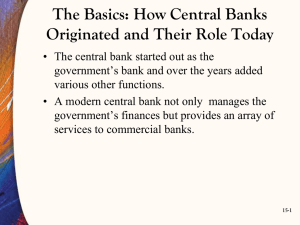
Foreign Banks and the Stability of Foreign and Domestic
Credit in CEECs
Sophie Brana, Delphine Lahet
LAREFI Working Paper N°2011-07
2011
LAREFI
Université Montesquieu-Bordeaux IV
Bâtiment Recherche Economie – 1er étage
Avenue Léon Duguit – 33 608 Pessac
LAREFI – LABORATOIRE D’ANALYSE ET DE RECHERCHE EN ECONOMIE ET FINANCES INTERNATIONALES
AUTHORS
Sophie Brana, LAREFI, Université Montesquieu Bordeaux IV
Delphine Lahet, LAREFI, Université Montesquieu Bordeaux IV
NOTICES
LAREFI Working Papers contain preliminary material and research results. They have been peer reviewed. They are circulated in order to
stimulate discussion and critical comment; any opinions expressed are only those of the author(s).
Copyright LAREFI. All rights reserved. Sections of this material may be reproduced for personal and not-for-profit use without the express
written permission of but with acknowledgment to LAREFI. To reproduce the material contained herein for profit or commercial use requires
express written permission. To obtain permission, contact LAREFI at cyril.mesmer@u-bordeaux4.fr.
ii
Contents
1
Introduction ...............................................................................................................................7
2
BACKGROUND ............................................................................................................................8
2.1
Foreign banks and the stability of financing .............................................................................. 8
2.2
Determinants of capital inflows: the push/pull factors ........................................................... 11
3
FINANCIAL FLOWS AND FINANCIAL INSTABILITY: the IMPACT OF FOREIGN subsidiaries.............. 13
4
CONCLUSION ............................................................................................................................ 25
5
References ............................................................................................................................... 26
iii
List of Tables
Table 1.
Determinants of the net inflows of foreign bank loans (balance of payments data) (19962008)*…………………. .......................................................................................................................... 20
Table 2.
Determinants of the volatility of inflows of foreign bank loans (balance of payments data),
random effects model (2000-2008) ................................................................................................... 22
Table 3.
Determinants of the volatility of domestic credit (2000-2008)......................................... 24
iv
List of Figures
Figure 1
Principal Component Analysis (PCA) (average 2000-2008)............................................... 15
v
Abstract
The huge presence of foreign banks in CEECs leads to a strong dependence to banking foreign
claims. They may be cross-border claims or claims of foreign subsidiaries located in the host country. Are
foreign banks a factor that attracts foreign claims in the host country? Does their presence stabilize
banking foreign flows and in fine the domestic credit supply? Using a Push&Pull framework, we adopt a
macroeconomic point of view by using balance of payments data concerning banking foreign financing
on all sectors in CEECs. Tests with panel data show that the presence of foreign banks is a substitute for
banking foreign loans and is not a factor of their stability. Nevertheless, it has a stabilizing role on the
domestic credit.
JEL classification: F23, F32, F36, G01, G21
vi
1
Introduction
Over the past decade, the banking system in Central and East European Countries (CEECs) has
been dominated by foreign banks. Since the end of the 1990s, governments have set up privatisation
programmes in a context marked by the presence of very few domestic banks, where few local investors
could afford to buy, leaving the door wide open to foreign investors. Today, on average, foreign banks
own three-quarters of CEEC bank assets (as opposed to 19% for the Euro zone and 23.8% for the
European Union). This share (Table 1, Appendices) even exceeds 80% in Bulgaria, Lithuania and Romania
and is over 90% in the Czech Republic, Estonia and Slovakia. Slovenia is the exception, where the share
was just 28.5% in 2007, as the authorities have given preference to the creation of two powerful publicowned banks. In CEECs, this marked presence of foreign banks stands alongside a significant
dependence on external financing. In 2009, the total amount of foreign banking loans (or foreign claims
to use BIS terminology) represented at least 70% of CEEC GDP, thereby engendering the risk of a sudden
withdrawal of capital (Table 2, Appendices). This involves either external and cross-border financing
(cross-border claims) from the parent bank to the borrowing country, or loans made by local subsidiaries
(local claims) via, possibly, financial support from the parent bank.
Further to the demise of Lehman Brothers, emerging countries suffered from significant
outflows of funds between Autumn 2008 and Spring 2009. All geographic areas were affected by these
“sudden stop” phenomena, but the focus was very much on emerging countries in Europe (Berthaud &
Colliac [2010]). On average, the flows of foreign bank financing fell by 13% over the area between June
2008 and December 2009 (BIS data), with very sharp falls in the Baltic States (around -30%), also in
Slovakia and, to a lesser extent in the Czech Republic ( 15%) and Slovenia ( 13%). The crisis that shook
major international banks between 2007 and 2009 has raised the question of the potential destabilising
role of parent banks for the host country in a situation of financial stress. Is the presence of foreign
banks in CEECs an attractive factor for outside financing? Is it a factor of stability or instability for this
7
financing? What are the consequences on the stability of the domestic credit? In the first section, we
have expounded empirical considerations as to the decisive factors behind foreign bankrolling and their
stabilising or destabilising effect on the host country; we have then analysed more precisely and from an
econometric viewpoint the stability of foreign bank financing in CEECs and the decisive factors therein,
and that of domestic credit. To this end and contrary to traditional literature concerning the role of
foreign banks in emerging countries, we have adopted a macroeconomic viewpoint using balance of
payments data on loans from foreign banks.
2
BACKGROUND
The study of the impact of the presence of foreign banks on the amount and the stability of
foreign bank financing and domestic credit lies at a crossroads between two trends in current literature.
2.1
Foreign banks and the stability of financing
Empirical literature as to the role of foreign banks in emerging countries and more particularly in
CEECs has, as a general rule, adopted a microeconomic stance to underline the differences in behaviour
between banks with foreign ownership and local banks. Studies have shown primarily that foreign
located banks are more efficient than national banks, and that compared with national banks their
business is less influenced by the economic conditions of the host country (Haselman [2006]). Moreover,
by adopting long-term strategies in their foreign operations, via the subsidiaries, they stabilise bank
credit for economies in times of crisis (Haselman [2006]; de Haas & Van Lelyveld [2006], [2010]; Arena &
al. [2007]). Haselman (2006) compares the determinants of credit supply of foreign banks and domestic
banks in 12 transition economies. He shows that the activity of foreign banks is influenced by economic
conditions in the host country, but more weakly than in the case of domestic banks. He concludes that,
8
because they rely less on domestic conditions than local banks, foreign banks would maintain their supply
of credit in times of crisis (when the local banks would reduce it), and help to stabilize the domestic credit
market. De Haas and Van Lelyveld (2006, 2010) lead to the same conclusion by introducing a dummy of a
banking crisis in credit supply equation. While this variable is not significant in the regressions for foreign
banks, it is significant and negative for local banks. They conclude that during periods of crisis, domestic
banks contracted their credit supply, which was not the case of foreign banks, who thus had a stabilizing
effect.This stabilising effect might be explained by the existence of an internal capital market with
banking groups, which enables parent banks to maintain their subsidiaries’ credit supply (de Haas & Van
Lelyveld [2006], [2010]; Dinger [2009]). The parent banks operate as a last-resort lender in the event of
recession in the host country or of internal problems with the subsidiary.
Nevertheless, the empirical literature is not completely convincing. If Haselman [2006] finds that
the foreign banks react less to the economic situation of the host country than the domestic banks, de
Haas and Van Lelyveld [2006, 2010] found the opposite result. The index of crisis used by them in their
demonstration is also problematic. Indeed, this index takes the value 1 (existence of a systemic banking
crisis) at periods when the share of the foreign banks was relatively weak (12% on average on the whole
of their sample). Apart from privatization transactions, it is often following the crisis of the domestic
banking systems, in the 90s, that the share of foreign banks has increased during period of restructuring.
It is thus logical that the index of crisis is significant for domestic banks but not for foreign banks1. In
addition, we can also suppose that foreign banks resist the crisis better, not because they use the
financial support of their parent bank, but simply because they are better managed or less fragile (less
non performing loans in asset portfolios). This assumption is confirmed by the result of Haas and Van
Lelyveld [2006, 2010] according to which only the greenfield foreign banks (completely created,
1
Moreover, the non significativity of a crisis dummy variable in the equation of foreign banks supply of credit, does
not suggest that foreign banks have not contracted their credit supply during crisis and therefore have a stabilizing
role.
9
compared to the take-over ones, acquired) follow their strategies of credit supply even if a shock affects
the host country: contrary to the take-over banks, they did not inherit non performing loans.
Then, the studies conclude the stabilizing role of the foreign banks in the CEECs because it is
implicitly supposed that emerging countries or countries in transition, and their banking systems, are
more unstable and fragile than the parent banks and the home countries. However, in all the
estimations of the above-mentioned studies, the supply of domestic credit in the CEECs depends
significantly on the financial health of the parent banks (indicator of profitability, or ratio of provisions):
so, foreign banks may have a destabilizing role on the domestic credit and the host country.
So, the stabilising character of the presence of foreign banks on domestic credit supply via the
parent/subsidiary link remains open to question. There are risks inherent with the parent bank/
subsidiary relationship (McGuire & Tarachev [2008]), for instance a parent bank in trouble may restrict
its financial support to subsidiaries. It may also arbitrate between subsidiaries and modulate its financial
support according to the state of the host country and to expected yields (substitution effect), and not
merely produce a support effect for the most fragile of its subsidiaries (de Haas & Van Lelyveld [2006]
and [2010]). So belonging to a large network of subsidiaries may have a destabilising effect for a
subsidiary and for the host economy.
Finally, there is no empirical evidence in these studies of the existence of financial support from
the parent to the subsidiary, which might explain the stability of the global supply of bank credit to the
economy in times of crisis, as this data is not available. It is simply supposed. To our knowledge, this
support has not been measured through foreign bank loans received by a given country. To see if the
presence of foreign banks in a country leads to greater stability of this financing and the domestic credit
supply, we need first and foremost to ascertain whether or not it is a factor of capital inflows. This latter
query leads us to consider another field of literature.
10
2.2
Determinants of capital inflows: the push/pull factors
Since the pioneering articles from Calvo & al. [1993] and Fernandez-Arias [1996], the decisive
factors for inflows of capital2 to emerging economies have been listed under two categories. The push
factors are factors outside the emerging country, i.e. rather unfavourable conditions for investment in
industrialised countries, which push flows in an emerging country, whereas pull factors, are inside and
specific to the emerging country, i.e. positive fundamentals which pull capital into a country3. Following
on from Calvo & al. [1993], who studied the role of traditional push factors (interest rates and economic
growth in developed countries) during the debt crisis of 1982, empirical studies have evaluated the
respective role of each category of factor and delivered different results according to the emerging
region. In particular, Jeanneau & Micu [2002], in a Push&Pull framework, have shown the significant role
of pull factors in Asia, and of push factors in Latin America4 over the period between 1985 and 2000 as
determinants for international bank claims5.
After the Asian crisis of 1997, literature focused on the study of contagion: transmission
channels for shocks and swings in sentiment from foreign investors (Forbes & Rigobon [2002]; Masson
[1999]). Thus, alongside the traditional Push&Pull variables, variables related to aversion to risk (such as
the high yield spread or the US swap spread) appeared significant to explain the capital flows to
emerging countries (Jeanneau & Micu [2002]).
In the end, few articles have tested banking variables as determinants for movements in capital
flows, particularly foreign bank loans. McGuire & Tarashev [2008], over the period between 1990 and
2007 and relating to determinants for international bank claims, introduced the criterion of quality of
2
In general in these studies, the data used is portfolio inflows (Fernandez-Arias, [1996] ; Chuhan & al., [1998]).
See Brana, Lahet [2010a] for a survey.
4
The authors show the positive impact of the growth posted by the lending country, or the country’s excessive
liquidity, thereby marking a difference with traditional literature, particularly Calvo & al. [1993].
5
Based on the BIS data base, Consolidated Banking Statistics. Loans between parent bank and subsidiaries are
compensated.
3
11
banks from lending countries6 alongside traditional macroeconomic factors, plus an indicator for the
openness of host countries towards foreign banks without using any particular analysis frame or any
variables for the soundness of host country banks. Hermann & Mihaljek [2010], focusing on cross-border
claims7 between 1993 and 2008 in the frame of a gravity model, have shown that in addition to distance,
to traditional variables relating to global and specific factors and to risk aversion indicators, the
soundness of banks in the lending country is a factor that explains the granting of loans to an emerging
country, whereas the soundness of local banks is a pull factor8. According to the authors, the attractive
nature of the soundness of local banks in CEECs apparently stems from the implantation of foreign
banks, even though no specific variable was used to measure this idea9.
Consequently, to study the role of foreign banks in the host country plus the attraction and
stabilisation of foreign bank financing, it would be wise, in a Push&Pull framework, to include the
soundness of lending country banks and that of host country banks, together with a variable that
accurately measures the presence of foreign banks in the local banking system as a pull factor,
something that has not really been achieved to date in published literature. We have adopted a
macroeconomic stance and used balance of payments data to address the evolution of foreign bank
financing granted to CEECs and the determinants thereof. Thus, like Haas et al. [2006] and Haselman
[2006], for whom the stable behaviour of foreign banks emerges through the refusal to tighten their
credit supply (in times of crisis in the host country), we will study the variation in foreign bank loans and
6
Evaluated by the banking sector’s stock market index, the expected frequency of default in the banking system and
the volatility of assets. For the latter two variables, indicators from Moddy’s.
7
Based on the BIS data base, Locational Banking Statistics. Loans between parent banks and subsidiaries are
included but the authors say nothing about them. It corresponds in fact to received cross-border claims included in
the “Other investment” category of the balance of payments.
8
The soundness of banks is measured by the gap between the banking sector’s stock market index and the reference
stock market index, which furthermore is open to criticism from the authors. A rising index implicitly reflects
inflows of foreign capital.
9
Simply a correlation of 0.7 between the soundness indicator used for the banking system and the share of local
banks with foreign ownership.
12
their standard deviation using the method developed by Garcia Herrero & al. [2007]10, to appraise the
volatility / stability of foreign bank financing received by CEECs.
3
FINANCIAL FLOWS AND FINANCIAL INSTABILITY: the IMPACT OF FOREIGN
subsidiaries
In CEECs as at December 2009, financing from foreign banks (or foreign claims to use BIS
terminology), was taking the form of cross-border claims (60%) and local claims (40%) granted by
foreign banks located in the host country. However, only 40% of these foreign claims are in local
currency (local in local), as opposed to 60% in foreign currency (international claims).
A Principal Component Analysis (PCA) casts light on the link between the amount and the type
of foreign claim (local or cross-border, in foreign or local currency), their volatility and the presence of
foreign banks set up in CEECs (Graph 1). First of all, the presence of foreign banks (foreign bank variable)
is correlated to the granting of local claims by the subsidiaries (to the detriment of cross-border claims).
It is also correlated to the granting of claims in local currency, a factor translating to a high proportion of
domestic credit itself granted in local currency (left of the graph). Inversely, countries with more crossborder claims (without the presence of foreign banks) have more foreign claims denominated in foreign
currency (International claims), a fact which ultimately helps to explain the “dollarization” of claims held
by resident non-financial agents (right of the graph). Additionally, these countries have a high credit
ratio on deposits, translating to a funding gap that can become a serious issue in the event of sudden
withdrawals of capital flows.
The presence of foreign banks in CEECs is associated with the financial development of these
countries (measured by the share of banking system assets in GDP) and with a certain degree of banking
efficiency. Indeed, this “efficiency”, measured by the ratio ‘number of employees/banking asset’ is
10
Calculation of the average standard deviation to analyse the stability of claims granted by Italian, Spanish and
American banks in a hundred countries.
13
inversely correlated to the share of foreign banks and the importance of multinational (parent) banks
(vertical axis).
However, the presence of foreign banks does not seem to be a pull factor. It would even appear
that local banking market development via the located subsidiaries might be a substitute for foreign
bank financing and precisely cross-border claims. Neither the share of external financing over GDP (FX
variable) nor the share of foreign bank loans over GDP (Foreign claims variable or FC) is correlated to the
percentage of foreign banks located in the country.
14
Figure 1
Principal Component Analysis (PCA) (average 2000-2008)
Variables (axes F1 and F2: 71,07 %)
1
Ef ficiency
0,75
F2 (19,78 %)
0,5
0,25
0
Loan volatility
Int ernat ional
Claims
Local claims
FX
Domestic credit
in foreign curr.
Cross border
Funding gap
Domestic credit
in local curr.
-0,25 Local in local
Foreign claims
(FC)
FC volatilit y
-0,5
FX volatility
%foreign banks
Creditors
Financial
concentrat ion
development
%multinational
Concentration
banks
of banking
system
-0,75
-1
-1
-0,75
-0,5
-0,25
0
0,25
0,5
0,75
1
F1 (51,29 %)
with:
- Foreign Claims (FC) : foreign bank claims ( % GDP).
- FX: total external financing (Direct investment, portfolio investment, and other investment, balance of payments statistics), %
GDP.
- Cross Border, Local claims, Local in Local, International claims: % total foreign claims.
- Domestic credit in local currency, Domestic credit in foreign currency: % of total domestic credit.
- Foreign banks: Share of foreign banks (% of assets in the banking system).
- Concentration of (external) creditors, concentration of banking system (in the host country): Herfindahl index.
- % Multinational banks: asset of the 20 biggest host country banks that are owned by the 20 largest multinational parent banks
(European banks).
- FC volatility: average standard deviation of foreign bank loans (Balance-of-Payment data)
- FX volatility: average standard deviation of total external financing.
- Loan volatility: average standard deviation of domestic credit.
- Financial development: financial development indicator measured by total asset of the banking system /GDP, %.
- Efficiency: number of employees in the banking system/banking asset.
- Funding gap: domestic credit/banking deposit.
Authors calculation with data from ECB, Bankscope, BIS and Datastream.
15
According to the hypothesis put forward by de Haas & Lelyveld [2010] and Dinger [2009], CEECs
appear to have an internal banking group capital market that involves flows between parent banks and
subsidiaries. We should therefore note a positive link between the presence of foreign banks (or the
percentage of parent banks operating in CEECs) and foreign bank flows. Yet the PCA does not seem to
indicate the existence of such a link.
Lastly, we note that the presence of foreign banks is no guarantee as to greater stability for
external financing. There seems to be a link between the instability of capital inflows (measured by the
average standard deviation) as sole foreign banking loans (FC volatility variable) and the percentage of
banking assets in the hands of foreign players. However, this instability of external financing does not
lead to volatility with regards domestic credit (Loan Volatility variable), with the two variables being at
opposite ends of the PCA horizontal axis. This might corroborate the hypothesis of a stabilising role from
inter-bank claims and parent bank/ subsidiaries relations.
Our econometric analysis is carried out in two steps. In the first step, tests make it possible to
specify the determinants of foreign banks financing and the stability of it. A second step allows us to
conclude on the role of foreign banks on the stability of the credit supply of the CEECs’ banking system.
As a starting point, the supply of foreign bank loans is traditionally associated with push and
with pull factors (Haselmann [2006]. The estimated equation for the determinants governing foreign
bank loans takes the following form:
K=c+Xα+Yβ+u
(1)
where K represents the net flows of foreign bank loans (balance of payments data), X is a vector
of pull (or domestic) factors and Y a vector of push (or external) factors.
16
We chose to use balance of payments statistics instead of BIS banking statistics on loans
from foreign banks for several reasons. K corresponds to the “other investment-banks” category of the
financial account of the balance of payments, on a net flow basis, and covers all creditors’ countries.
Conversely, BIS statistics measure the gross international claims of only BIS reporting banks (27 major
banking centers) vis-à-vis individual countries. Moreover, these data include the exposures of their
affiliates and are collected on a consolidated basis, so inter-office positions are netted out. When it
comes down to it, balance of payments statistics allow for better matching the foreign banks behaviour
on longer time series.
Pull factors are represented by the fundamentals of the host country. They are approximated by
the sovereign rating that we build using the numerical values of the Standard & Poor’s and Moody’s11
indices and working out the average. The advantage of this variable is that it is a good synthetic
indicator of a country’s fundamentals and that it is closely monitored by international investors in their
investment strategies (Rating variable). We have also taken on board the GDP growth rate in each
country (host country growth). We have also sought to ascertain whether more institutional variables
have had an impact on inflows of bank loans. To do so, we have used the transition indicators of the
EBRD, which gauge the progress of transition towards a market economy12. We have calculated a mean
indicator for the whole economy (Variable Score), and have used the indicator pertaining more
specifically to the banking sector (Bank Score). Lastly, we have introduced a dummy variable, using the
value 1 as from a country’s date of joining the European Union, and 0 before that date (EU Integration).
Inflows of capital may also be explained by push factors. These include the economic and
financial situation of the home countries. As over 90% of the foreign bank capital invested in East
European countries comes from Europe, we have introduced a variable representing Euro zone growth
(Euro zone growth). We have also introduced a variable representing the yield differential between the
11
Long-term ratings in foreign currency.
See Papaioannou [2009] for an analysis of the impact of the institutional environment on international
movements of bank financing.
12
17
two zones (East European countries i and the Euro zone), based on the 3-month rates of Treasury bonds
(Spread variable). Push factors also include variables relating to financial stress and appetite for risk.
These variables, determined on international markets, may explain pure contagion effects and explain
inflows and outflows of capital. We have therefore introduced (Dailami & al. [2008]; Coudert & al.
[2008]), general monetary conditions (M3 growth rate in the Euro zone, the M3 excess liquidity/GDP
ratio for all OECD countries), default risk indicators (Ted Spread, High Yield Spread, for the United States
and Europe) and volatility risk indicators (VIX).
In order to test the impact of the presence of foreign banks operating locally, we have added a
foreign banks variable to pull factors, to measure the share of the host country’s banking assets that are
held by foreign banks. We have also introduced the state of health of banks in the lending country (push
factor) and that of banks in the borrowing country (pull factor). To this end, we have used Bankscope
data for the banking systems in the 9 home countries from where the major banking groups operating in
CEECs originate13. The variables we have used measure the degree of the bank’s capitalisation (equity to
total asset), the degree of asset liquidity (liquid assets to total asset), profitability (profits to total asset)
and the quality of credit portfolio (ratio of provisions for bad loans to total loans) (de Haas & Van
Lelyveld [2006], Haselman [2006], Derviz & al. [2007]).
Estimations have been made with stationary variables. The Wald test revealed
heteroscedasticity of residuals which was corrected in the fixed effects model by the White estimator.
To take account of the heteroscedasticity and cross-section of residuals (there is no serial correlation),
we have also estimated a FGLS model (method developed by Parks & Kmenta) and a PCSE (OLS models
with panel-corrected standard errors, Beck & Katz method). Estimations are very close, perhaps a sign of
the robustness of results.
13
Italy, Germany, Austria, France, Sweden, Greece, Belgium, Denmark and the Netherlands. See Brana & Lahet
[2010b] for an analysis of the presence of major European bank groups in CEECs.
18
Our empirical results (Table 3) show firstly the importance of the parent bank’s financial
situation, thereby confirming the results given by de Haas & Van Lelyveld [2006 & 2010]. Flawed
solvency reduces the amount of bank loans made abroad. Multinational banks do therefore tend to
transfer financial shocks suffered at home. By contrast, the financial situation of the host country’s
banking system does not appear to be significant.
19
Table 1.
(1996-2008)*
Determinants of the net inflows of foreign bank loans (balance of payments data)
Fixed effects model
Coef.
t-student
FGLS model
Pr.
Coef.
t-student
PCSE model
Pr.
Coef.
t-student
Pr.
Euro zone growth
328.97
1.20
0.234
130.67
0.50
0.620
323.48
0.72
0.471
Host country
growth
49.46
2.13
0.035
26.47
1.71
0.088
46
1.84
0.066
Provisions for
parent bank bad
loans (% total
loans)
-1697.2
-3.21
0.002
-1203.64
-3.40
0.001
-1809.1
-3.19
0.001
Parent bank
profits (% assets)
-2469.42
-1.69
0.093
-1259.17
-1.66
0.096
-2553.7
-2.00
0.045
% foreign banks
in host country
-19.93
-2.06
0.041
-13.48
-2.24
0.025
-20.43
-2.74
0.006
EU integration
1534.64
2.55
0.012
1626.76
3.40
0.001
1427.16
2.11
0.035
Constant
7229.63
2.82
0.006
5048.51
3.49
0.000
7702.69
3.38
0.001
N° obs = 129
R-sq: within = 0.4632
R-sq = 0.4285
* With the exception of the “euro zone growth” variable, only significant variables are given.
Results then show that foreign banks are firmly into a “pull” strategy. It is the economic
conditions of the host country, not of the home country, that determine the investment strategies of
international banks. This would confirm the conclusion made by Haselmann [2006], according to which
foreign banks prefer long-term strategies in CEECs. Integration into the EU has also been a potent factor
of attraction, again pointing to long-term investment strategy.
This result appears to be reinforced by the fact that no variable regarding appetite for risk, and
no spread variable – measuring yield differentials between zones – appeared significant. Clearly, foreign
bank financing in no way responds to any form of short-term financial logic, although this does not stop
multinational banks from adopting arbitration strategies between zones (home country, other emerging
countries), as shown by the negative sign with their profitability as a determinant for their foreign
financing operations (however, this variable is only of very little significance).
20
Lastly, as the PCA would suggest, the implantation of foreign banks is not associated with the
increase in foreign bank financing, which would imply that foreign banks operating locally find local
financing resources, probably via deposits.
Our econometric analysis confirms, however, that the presence of foreign banks in CEECs does
not protect these countries from the volatility of inflows of foreign bank loans (Table 4).
21
Table 2.
Determinants of the volatility of inflows of foreign bank loans (balance of payments
data), random effects model (2000-2008)14
Modèle à effets aléatoires
Modèle FGLS
Modèle PCSE
Coef.
t-student
Pr.
Coef.
t-student
Pr.
Coef.
t-student
Pr.
% foreign banks
in host country
0.039
2.32
0.021
0.018
2.91
0.004
0.053
3.38
0.001
Amount of
foreign bank
loans
-0.0006
-2.29
0.022
-0.0003
-2.09
0.036
-0.0007
-4.61
0.000
Variation of host
country rating
-1.083
-2.74
0.006
-0.805
-3.27
0.001
-1.247
-5.16
0.000
Provisions for
parent company
bad loans (%
total loans)
0.835
2.09
0.037
0.849
3.38
0.001
0.822
2.38
0.017
Constant
-1.954
-1.24
0.216
-1.282
-1.47
0.141
-2.683
-1.68
0.094
nb obs = 80
R-sq: within = 0.2351
R-sq: 0.3571
The volatility of foreign bank loans to CEECs depends positively on the share of banking assets
held by foreign banks in these countries. It falls in pace with the amount of these foreign loans, which is
logical, and when the country’s rating improves. Lastly, as foreign bank loans are essentially the doing of
European banks, any deterioration in the quality of their balance sheet (a rise in provisions for bad loans
in percentage of total loans) increases the volatility of foreign financing.
Thus, the presence of foreign banks operating in the host country clearly emerges as a factor of
volatility with foreign bank loans. This result runs counter to the idea according to which foreign banks
might have a stabilising effect on the host country. Foreign bank financing actually depends very much
on the financial situation of the parent company.
In a second step, we investigate the potential role of foreign banks on stability or volatility of
domestic bank credit. Unlike the existing literature, we adopt a macro perspective and take into account
14
2
The Breush-Pagan test [(χ (1) = 62.35] reveals a degree of heteroscedasticity, probably due to the effects of size,
that we have corrected using the White estimator. The Hausmann test indicates that the random effects model is
2
preferable to the fixed effects model [(χ (4) = 0.53]. The Lagrange de Breush-Pagan multiplier test confirms that
2
there are random specific effects [(χ (1) = 18.08]. Lastly, the Wooldridge test does not indicate any presence of
residual self-correlation [F(1.9) = 0.026].
22
the overall supply of credit and the foreign bank financing (thereby integrating relations parent
companies / subsidiaries).
23
Determinants of the volatility of domestic credit (2000-2008)15
Table 3.
Coef.
Fixed effects model
t-student
Pr.
Coef.
PCSE model
t-student
Pr.
% foreign banks in host
country
-.000489
-2.00
0.047
-.00044
-3.43
0.001
Amount of foreign bank loans
3.00e-06
4.19
0.000
2.51e-06
2.71
0.007
Domestic credit on GDP
-4.65e-08
-3.25
0.002
-2.46e-08
-5.61
0.000
Constant
.1048
5.91
0.000
.1125
13.04
0.000
N° obs = 134
R-sq: within = 0.1136
Coef.
% foreign banks in host
country
Fixed effects model
t-student
Pr.
-.00034
-1.41
0.161
R-sq: 0.3451
Coef.
PCSE model
t-student
Pr.
-.00020
-2.04
0.042
Amount of foreign bank loans
2.75e-06
3.78
0.000
2.34e-06
2.57
0.010
Domestic credit on GDP
-3.07e-08
-2.17
0.032
-1.73e-08
-7.32
0.000
Volatility of foreign bank loan
(cross border)
-.001218
-2.42
0.017
-.00195
-3.75
0.000
Host country growth
0.04396
2.25
0.027
.08298
9.73
0.000
Constante
.08989
5.09
0.000
.08202
10.06
0.000
N° obs = 129
R-sq: within = 0.1666
R-sq: 0.6106
The presence of foreign banks reduces the volatility of domestic credit, which confirms the
results of other studies (Haselman 2006; De Haas and Van Lelyveld, 2006, 2010). This stabilizing effect
goes through two channels. The first is that the presence of foreign banks increases the supply of credit
financed from local resources (domestic deposits) in local currency. These local assets in local currency
are more stable than cross-border claims. The second channel is related to the access of foreign banks to
international financing through their parent companies. While the amount of cross-border bank loans
(variable amount of foreign bank loans) is positively correlated to the volatility of domestic credit, the
volatility of these flows (variable volatility of foreign bank loans) is negatively related to that of domestic
credit. We can see the sign of a buffering role of external financing from the local instability. This result
15
The heteroskedasticity has been corrected in the fixed effects model using the White estimator. Wooldridge test
indicates the existence of autocorrelation that we have corrected using a panel-specific autocorrelation structure in the
regression with panel-corrected standard errors (PCSE). We cannot use this AR1 autocorrelation structure with
feasible generalized least squares because the estimate requires a panel cylinder.
24
confirms the existence of a "support effect" from the parent bank (see de Haas and van Lelyveld, 2010).
The positive impact of the growth rate of the host country (host country growth variable) on the volatility
of domestic credit confirms funding by capital inflows of the credit boom and growth. Finally, consistent
with traditional literature, the credit volatility is inversely related to its amount, measured in terms of
financial development (domestic credit to GDP ratio).
4
CONCLUSION
Contrary to commonly accepted opinion, the strong presence of foreign banks in CEECs is
neither a factor for capital inflows nor a factor of stability for this financing. On the contrary, the local
implantation of foreign banks could be a substitute for external/foreign bank loans (cross-border
claims). In favouring local claims and loans in local currency, foreign banks operating locally help to
promote the stability of domestic credit and the rise in the deposit over credit ratio, thereby rendering
host countries less vulnerable to the risk of mass capital flow withdrawals.
The presence of foreign banks is however associated with greater instability of foreign bank
loans. We can see here the active management of the balance sheets of the foreign banks operating
locally, which plays on loans from their parent companies to stabilise their credit supply. This result
would appear to confirm the conclusions from other works, according to which the presence of foreign
banks would make domestic credit less sensitive to local conditions. We might, however, also interpret
this result in a less favourable light for the host country. The volatility of foreign bank financing may
indeed also be explained by the financial situation of parent banks. In times of crisis, they adjust their
foreign financing, thereby transferring financial instability to host countries. Over the entire study period,
however, the stabilizing effect of the presence of foreign banks dominate.
25
5
References
ARENA M., RIENHART C., Vazquez F. 2007, The lending channel in emerging economies : Are foreign
banks different ?, IMF/WP 07/48, February.
BANQUE CENTRALE EUROPEENNE 2008, EU Banking structures, october.
BERTHAUD F., COLLIAC S. 2010, Quels pays émergents ont été victimes d’un arrêt brutal des entrées de
capitaux pendant la crise ? , Trésor-Eco, Lettre n° 76, July.
BRANA S., LAHET D. 2010a, Determinants of capital inflows into Asia: the relevance of contagion effects
as push factors, Emerging markets review, vol. 11, n° 3, 273-284.
BRANA S., LAHET D. 2010b, La présence des banques étrangères en Europe de l’Est : quels risques
financiers, Revue d’Etudes comparatives Est-Ouest, Vol. 41, n°1.
CALVO G., LEIDERMAN L., REINHART, C. 1993, Capital flows and the real exchange rate appreciation in
Latin America: the role of external factors, IMF Staff Papers, 40, March.
COUDERT V., GEX M. 2008, Does risk aversion drive financial crisis? Testing the predictive power of
empirical indicators, Journal of Empirical Finance, 15, 167-184.
CHUAN P., CLAESSENS S., MAMINGI N. 1998, Equity and bond flows to Latin America and Asia: the role
of global and country factors, Journal of Development Economics, 55, p.439-463.
DAILAMI M., Masson P., PADOU J.J. 2008, Global Monetary Conditions versus Country-Specific Factors in
the Determination of Emerging Market Debt Spreads, Journal of International Money and
Finance, 27(8), December, 1325-1336.
DE HAAS R., VAN LELYVELD I. 2006, Foreign banks and credit stability in central and Eastern Europe. A
panel data analysis, Journal of Banking and Finance, 30, 1927-1952.
DE HAAs R., VAN LELYVELD I. 2010, Internal capital market and lending by multinational bank
subsidiaries, Journal of Financial Intermediation, Vol.19, 1-25.
DERVIZ A., PODPIERA J. 2007, Cross-border lending contagion in multinational banks, ECB Working Paper
Series, n° 807.
26
DINGER V. 2009, Do foreign-owned banks affect banking system liquidity risk?, Journal of Comparative
Economics, Vol. 37, 647-657.
FERNANDEZ-ARIAS E. 1996, The new wave of private capital inflows: push or pull?, Journal of
Development Economics, 48 (2).
FORBES K., RIGOBON R. 2002, No contagion, only interdependence: measuring stock market comovements, Journal of Finance, 57(5), 2223-2261.
GARCIA HERRERO A., MARTINEZ PERIA S. 2007, The mix of international banks’ foreign claims:
Determinants and implications, Journal of Banking and Finance, vol. 31, 1613-1631.
HASELMANN R. 2006, Strategies of foreign banks in transition economies, Emerging Markets Review,
vol. 7, 283-299.
HERMANN S., MIHALJEK D. 2010, The determinants of cross-border bank flows to emerging markets
;new empirical evidence on the spread of financial crises, BIS WP, n°315, July.
JEANNEAU S., MICU M. 2002, International bank lending to emerging market countries: explaining the
1990s roller coaster, BIS Quarterly Review, March, 52-64.
MASSON P. 1999, Contagion : macroeconomic models with multiple equilibria, Journal of International
Money and Finance, 18(4), August, 587-602.
MCGUIRE P., TARASHEV N. 2008, Bank health and lending to emerging markets, BIS Quarterly Review,
December.
PAPAIOANNOU E. 2009, What drives international financial flows? Politics, institutions and other
determinants, Journal of Development economics, 88(2), March, 269-281.
27
Annex 1: The characteristics of banking systems in CEECs (2007)
Number of
banks
Number of banks
under foreign
control
Share of foreign banks
(% of assets in the
banking system)
Share of European banks
(% of assets in the
banking system)
Bulgaria
29
21
79,5
81,6
Czech Republic
56
34
91,5
96,1
Estonia
15
13
98,8
98,8
Latvia
31
13
55,4
62,5
Lithuania
80
8
83,7
83,7
Hungary
206
30
54,3
57,4
Poland
718
54
62,1
70,5
Romania
42
35
82,1
82,1
Slovenia
27
11
28,5
28,5
Slovakia
26
25
95,9
95,9
European Union 13*
6128
1111
17,4
19
European Union 27
8348
1711
20,5
23,8
* Countries from euro-zone in 2007.
Source : Authors calculation with ECB data (2008).
28
Annex 2: Foreign claims (%GDP) (December)
Bulgaria
Czech Republic
Estonia
Latvia
Lithuania
Hungary
Poland
Roumania
Slovenia
Slovakia
2007
2009
87,9
99,3
174,7
416,5
100,5
98,2
57,4
72,6
80,3
107,8
91,8
92,9
146,6
118,3
90,6
112,9
69,6
71,4
78,8
84,7
Source : BIS and Datastream, Authors calculation.
29
RECENT LAREFI WORKING PAPERS
For earlier LAREFI Working Papers, please go to http://www.larefi.org:discussionopapers.
All Discussion Papers can be downloaded free of charge
2011-001 Trade and Investment in Latin America and Asia : Potential Perspectives from Further
Integration Antoine Bouët
2011-002 Social responsibility of the countries and their international trade : A gravitational
approach Jean-Marie Cardebat, Alexandru Dimitrescu
2011-003 Gouvernance territoriale durable via les PME : l’exemple de la région Aquitaine Anne
Musson
2011-004 Offshoring and export performance in the European automotive industry Raphaël
Chiappini
2011-005 Envois de fonds et allocation du temps des enfants au Niger : L’effet indirect des chocs
négatifs Delphine Boutin
2011-006 D’une crise à l’autre : mesurer l’impact des prix alimentaires sur la pauvreté Delphine
Boutin
2011-007 Foreign banks and the stability of foreign and domestic credit in CEECs Sophie Brana,
Delphine Lahet
2011-008 Assessing the Effects of Financial Heterogeneity in a Monetary Union : A DSGE
Approach Christina Badarau, Grégory Levieuge
2011 -009 Which policy-mix to mitigate the effects of financial heterogeneity in a monetary
union ? Christina Badarau, Grégory Levieuge
2011-010 A note of poor-institution traps in international fiscal policy games Pierre-Henri Faure
2011-11 Should gouvernments be more permissive towards corruption ? Pierre-Henri Faure
30









